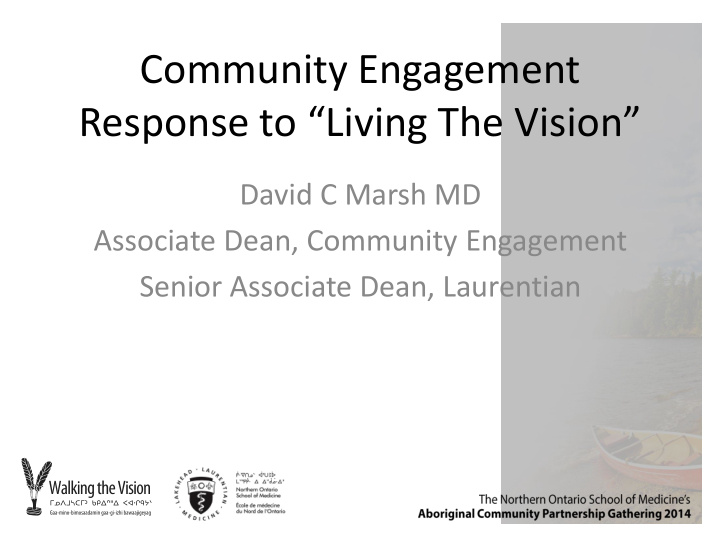



Community Engagement Response to “Living The Vision” David C Marsh MD Associate Dean, Community Engagement Senior Associate Dean, Laurentian
Community Engagement A fundamentally relational, mutually beneficial practice based on shared values and aspirations and actualized in a range of engagement activities explicitly geared to local community (re)development and social justice outcomes. Members of a specific community and interdependent partners work together as “friends” to identify and develop new ways to resolve issues affecting the well-being and life experience of the members of that community. Source: Adapted from Sutherland et al, 2004
Community Engagement Portfolio • Aboriginal Affairs • Francophone Affairs • Admissions and Learner Recruitment • Clinical Placements (Housing and Electives) • Integrated Clinical Learning (Health Sciences)
Cultural Safety • Expand opportunities for NOSM staff, faculty and learners to learn “culturally safe” behaviour • (i.e., expanded on- campus offerings and the “Adopt -a- Faculty” program ) • Cultural Competency Training with CEPD • Mandatory Preparatory Sessions for 106 • Elders-On-Campus available to staff, faculty and learners • Elder Participation in Senior Leadership Group
Community Benefits from 106 • LCCs, and NOSM staff, faculty and learners to collaborate during CBM 106 placement planning to ensure appropriate and beneficial experience for the community • Youth are engaged through a variety of activities during CBM 106 • Elders are engaged • Annual Local Community Coordinator Training • Funding tied to participation and development of plan • Learner meets LCC during event • Mandatory Preparatory Sessions for 106 for Learners • 106 Site Readiness Committee chaired by Aboriginal Affairs • Elder’s Group now more formalized and meeting regularly • Recruitment Package for Learners to bring to community
Aboriginal Reference Group • Build awareness of the role of the ARG within Aboriginal communities • Increase information sharing between NOSM, ARG and partner communities • ARG Membership and Representation clarified • ARG Meetings Improved • ARG Membership and Role on Website with photos • ARG Highlighted in NOSM Publications for Communities • ARG Newsletter planned • ARG Members report back from organizations increasing
Mutual Benefits • NOSM to ensure that the benefits of the community placements are shared with the partner Communities • 106 Placement includes Community Presentation • Opportunity for Learners to share what they have learned • Also to provide useful information to community gathered before and during placement • Mandatory Preparatory Sessions for 106 • Encourage Learners to provide inspiration and role modeling to youth in community
Continuity of Relationships • NOSM and partner communities to create opportunities for students to re-visit their first year host communities and additional communities at points further along in their medical studies (i.e., during residency) • Electives Catalogue now on-line and includes information on Aboriginal Health training opportunities • Research and clinical electives possible with appropriate faculty supervision • Service Learning options new to curriculum with longitudinal elective credit • Rural Family Medicine Program established • Increasing number of elective placements for visiting learners (including PG)
Community Engagement A fundamentally relational, mutually beneficial practice based on shared values and aspirations and actualized in a range of engagement activities explicitly geared to local community (re)development and social justice outcomes. Members of a specific community and interdependent partners work together as “friends” to identify and develop new ways to resolve issues affecting the well-being and life experience of the members of that community. Source: Adapted from Sutherland et al, 2004
Recommend
More recommend